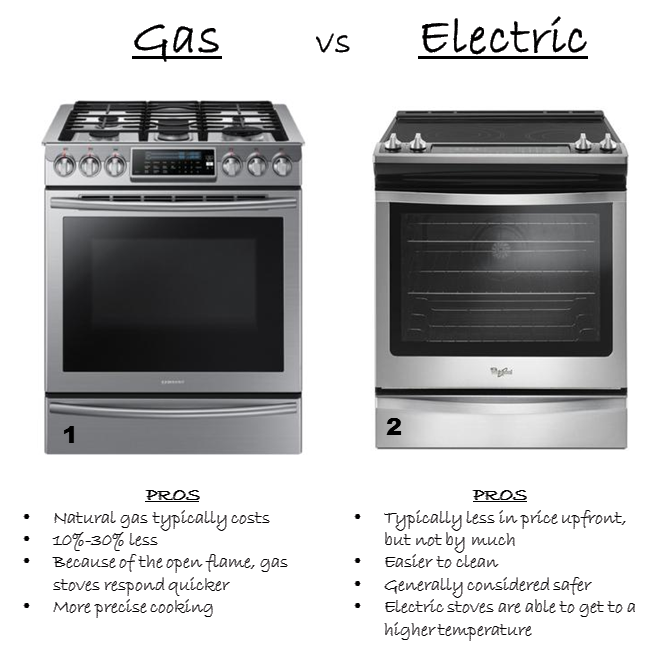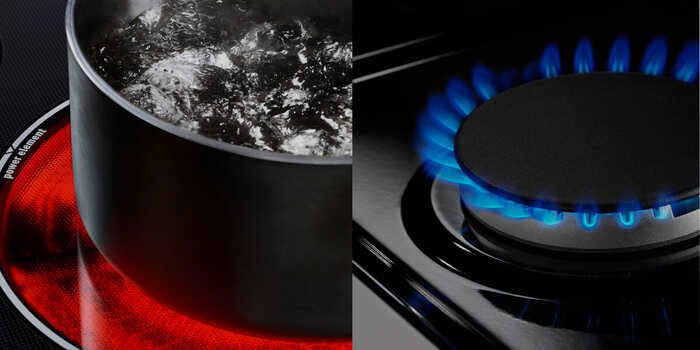Introduction
Electric ranges use metal heating components, while gas ranges use an open flame. Gas stovetops are more versatile because of their fast temperature adjustments, while electric ovens are better for baking and roasting thanks to their dry, consistent heat. Whether you go with a gas or electric stove, know that either one will encourage your inventiveness in the kitchen. Find out which type of stove is more suited to your cooking style by reading on to learn about the features of both gas vs electric range.
Cooktop with Gasoline
Most homeowners prefer gas heating systems because they provide instant heat and allow for instantaneous adjustments to the temperature. Gas allows for more visual feedback about temperature. Use whatever pot or pan you like on a gas stovetop because the grates are sturdy. To hear some homeowners tell it, they're just drawn to the culinary challenge of preparing meals on an open flame. Buyers with a gas line installed in their kitchen are prime candidates for a gas range. Unless they complete their kitchen renovation, most people will not spend the extra money necessary to establish a gas line to use a new item that requires it.

An Explanation of How a Gas Oven Operates
It's a range or cooktop that uses combustible gases as its fuel. Natural gas and liquefied petroleum gas (LPG) are the most popular options in Pakistan. Households receive natural gas through a system of pipelines, while in places without such a system, liquid petroleum gas (LPG) is stored and consumed with gas cylinders. Following these guidelines, you can safely utilize LPG gas cylinders in your house.
Stovetop Oven
For homes without gas lines, sleek glass-top electric cooktops are a popular and affordable alternative. Products can heat food faster than gas stoves and may be cleaned with less effort. These stoves' classy aesthetic makes them a natural fit for modern kitchens with little cabinetry and glass or stone surfaces. They are typically better than gas stoves at maintaining a low temperature. While gas stoves receive all the glory for producing restaurant-quality meals, electric stoves are the workhorses behind the scenes in commercial and residential kitchens.
Explaining the Function of an Electric Oven
In contrast to gas stoves, electric stoves do not use open flames to heat food; instead, they employ a heating method based on electrical induction, in which electricity is conducted by a wire embedded in the cooktop surface. Glass-ceramic surfaces are commonplace on induction stoves, one of the high-end electric cooktops. You will be better positioned to decide if you understand the functional differences between electric range vs gas range.
Prices of Gas and Electricity
However, gas is more affordable than electricity. But if you're starting from scratch and installing a range, the gas range installation will be more expensive. If you're looking for easy-to-maintain content, go with a gas stove. They are more long-lasting and resilient. Electric ranges are more affordable upfront than gas ranges.
Dual-Fuel Range
A dual-fuel range has an electric vs gas range, allowing the best of both worlds in the kitchen. You can instantly adjust the temperature on the cooktop while keeping the oven at a constant temperature with these hybrid ranges that combine a gas stovetop and an electric oven. These models come with a higher price tag. They add around $2,000 to the price of a standard gas or electric stove.
In Terms Of Cost, Which Option Is Preferable?
Assuming identical features and sizes, there is little to no price difference between gas and electric ranges and ovens. A product's pricing is mainly determined by its features and design. Appliances get more expensive as the number of optional features grows, and the design gets fancier. In comparison to single-fuel ranges of either gas or electric cooking power, the price of a dual-fuel range is higher.

Conclusion
Cooking ranges are a manageable factor in how imaginative you may be in the kitchen. Any method is open to you. On the other hand, gas stoves allow for a wider variety of cooking techniques that traditionally require an open flame, such as charring and grilling. A gas burner is a terrific option if you want to do some high-heat sautéing or stir-frying. To avoid burning, food must be constantly shifted around the pan when using these methods. The ability to utilize the pan's sides to flip or rotate food while it cooks is made possible by flames extending up the cooking vessel's sides. Although gas stoves allow for direct cooking over an open flame, electric stoves can still be used for various grilling, frying, stir-frying, and sautéing methods.




